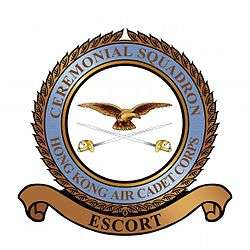Hong Kong Air Cadet Corps
 Hong Kong Air Cadet Corps Emblem | |
| Formation | 7 April 1971 |
|---|---|
| Type | Aviation |
| Headquarters | Old Hong Kong International (Kai Tak) Airport |
| Location |
|
Membership | 3263 cadets (youth) with 1588 adult members |
Official language | Cantonese, English |
| Website | www.aircadets.org.hk |
| Hong Kong Air Cadet Corps | |||||||||||
| Traditional Chinese | 香港航空青年團 | ||||||||||
|---|---|---|---|---|---|---|---|---|---|---|---|
| Simplified Chinese | 香港航空青年团 | ||||||||||
| |||||||||||
The Hong Kong Air Cadet Corps (Chinese: 香港航空青年團) is a voluntary uniformed group (although people working at headquarters get paid)[1] subsidised by the Home Affairs Bureau of the Hong Kong government and is registered under the Societies Ordinance as a non-profit making charitable organisation. Created in 1971 with ties to the British Armed Forces' Combined Cadet Force. It is an aviation-orientated, disciplined youth organisation, which aims to provide its members with initial aviation education, to develop their leadership capabilities and to promote their social awareness through community service. It is also an organisation supported by Cathay Pacific Airways and Dragon Air for aviation training.[2]
Apart from training in aviation knowledge, the HKACC also organises outdoor activities such as parachuting, rifle drill, familiarisation visits, hiking, night journeys, field training camp, and even flag days. In the summer, canoe courses and other aquatic activities are organised. In addition members of the Corps are obliged to take part in community service.
They are divided into 7 wings, Hong Kong Island, New Territories East, New Territories West, Kowloon East, Kowloon West, No 6 and Operations Support Wings. Those wings are further divided into squadrons; each squadron consists of a minimum of 35 cadets. Most of the squadrons are based at secondary schools for recruitment and training purposes.
Organisation

The Commanding Officer of the Hong Kong Air Cadet Corps is Group Captain LEE Kwok Wing. As HKACC chief executive officer, the Commanding Officer is responsible to the Executive Board for the Corps day-to-day operations.
The Commanding Officer Office co-ordinates a number of specialist functions at headquarters level, namely administration of the Honorary Officers Scheme; legal affairs; vocational qualifications; and liaison with the British and Canadian Air Cadet Organisations.
The Administration & Support Group discharges the administrative and support functions necessary for the daily running of the Corps. Its portfolio encompasses the routine administrative function of capital project, personnel, financial and properties management; organisation of adventure activities; information technology; interface with government policy bureaux and funding agencies; public affairs; logistics and supplies; and medical support.
The missions of the Institutional Advancement Group include liaison with the Central Government, government departments, mainland organisations, parents and other uniformed groups; international and mainland exchanges; and special developmental projects.
The Operations Group is in direct command of the five operational wings, and is responsible for organising and co-ordinating the activities of cadet and university squadrons. The Operations Group sees to that the functioning of its subordinate units are in line with the training objectives set out by the Headquarters, and that the Corps community services commitments are satisfactorily fulfilled.
The Training Group establishes the training standards and syllabus within the Corps. Such standards are constantly updated in light of community needs and technical advancements. The Training Group also runs advanced and specialist courses such as aviation education programmes; adult training; cadet non-commissioned officer training; and skills training.
The Flying Squadron organises air experience activities for the Corps. It also oversees flight operations and flight safety according to Civil Aviation standards.
Advanced Aviation Education Programme (AAEP) Scholarship
The AAEP was first introduced in 1997 and available only to members of HKACC and other uniformed youth organisations. In 2000, AAEP opened its door to the general public and it was in that year that Cathay Pacific Airways became the co-organiser of the Programme. This year the Community College of City University also joined us as our third co-organiser. The Programme aims to provide the participants with the ground training necessary to take the Australian Civil Aviation Safety Authority (CASA)General Flying Practical Test (GFPT).
Participants who passed all assessments will be awarded with a Certificate of Achievement issued by HKACC. AAEP graduates can apply for credit exemption when applying for the Associate Degree of Science in Airport Operations and Aviation Logistics (AScAOAL) offered by the Community College of City University. HKACC cadets who have passed the Programme will be deemed to have passed all Aviation Education (AE) subjects as required for the achievement of the Senior Cadet and Staff Cadet classifications.
Participants must complete the following 8 compulsory subjects divided into two modules which comprise a total of 20 sessions:
Technical modules
- Aerodynamics (ADY)
- Aircraft general Knowledge (AGK)
- Operation, performance and planning (PERF)
- Flight rules & air laws in Australia (LAW)
Navigation Modules
- Navigation (NAV)
- Meteorology (MET)
- Radio Communication (RT)
- Human Performance and Limitation (HPL)
Practical module
- Flight Simulation Training*(FST) conducted by instructors of the New Zealand (HK) Flight Training Academy
Squadrons

Most of the squadrons of the Hong Kong Air Cadet Corps are part of the Operations Group, which is divided into six wings, numbered one to six, and the Ceremonial Squadron under Ceremonial Wing, Training Group.
| Squadron | Wing |
|---|---|
| Ceremonial Squadron | Training Group |
| 101 Squadron | No 1 (Hong Kong Island) Wing |
| 102 Squadron | |
| 103 Squadron | |
| 104 Squadron | |
| 105 Squadron | |
| 106 Squadron | |
| 107 Squadron | |
| 108 Squadron | |
| 201 Squadron | No 2 (Kowloon East) Wing |
| 202 Squadron | |
| 203 Squadron | |
| 205 Squadron | |
| 206 Squadron | |
| 212 Squadron | |
| 213 Squadron | |
| 214 Squadron | |
| 301 Squadron | No 3 (New Territories East) Wing |
| 302 Squadron | |
| 303 Squadron | |
| 304 Squadron | |
| 308 Squadron | |
| 313 Squadron | |
| 401 Squadron | No 4 (Kowloon West) Wing |
| 402 Squadron | |
| 403 Squadron | |
| 404 Squadron | |
| 405 Squadron | |
| 406 Squadron | |
| 407 Squadron | |
| 408 Squadron | |
| 501 Squadron | No 5 (New Territories West) Wing |
| 502 Squadron | |
| 503 Squadron | |
| 504 Squadron | |
| 505 Squadron | |
| 506 Squadron | |
| 507 Squadron | |
| 508 Squadron | |
| 601 Squadron | No 6 Wing |
| 602 Squadron | |
| 603 Squadron | |
| 604 Squadron | |
| 605 Squadron | |
| 606 Squadron | |
| 607 Squadron | |
| 608 Squadron | |
| 609 Squadron | |
| Central Training Squadron |
Ranks
| Rank | Pilot Officer | Flying Officer | Flight Lieutenant | Squadron Leader | Wing Commander | Group Captain | Air Commodore |
| Insignia |  |  |  |  |  |  |  |
| Notes |
| Rank | Instructor | Sergeant Instructor | Warrant Officer | Officer Trainee | Officer Cadet |
| Insignia |  |  |  |  |  |
| Notes | Those who are 21 years old or have a Secondary 5 education and have completed an instructors training course. | Sergeant and Warrant Officer Instructors who are undergoing training to become Commissioned Officers. | Those who are 21 years old and have a university or specialist degree, who are now undergoing training to become Commissioned Officers. |
| Rank | Cadet | Cadet Lance Corporal | Cadet Corporal | Cadet Sergeant | Cadet Flight Sergeant | Cadet Warrant Officer |
| Insignia |  |  |  |  |  |  |
| Notes | Young people aged 11–20 who can speak Cantonese and with basic English capabilities. |
Fleet
Helicpoters used for flight experience in Hong Kong include:
Glider training is provided by Canada/Australia and private flying clubs in Canada / New Zealand.
References
- ↑ "HONG KONG AIR CADET CORPS INTERNAL STAFF RECRUITMENT" (PDF). Hong Kong Air Cadet Corps. Retrieved 6 December 2007.
- ↑ "HKACC Aviation Training". Hong Kong Air Cadet Corps. Archived from the original on 14 April 2008. Retrieved 22 November 2007.
External links
| Wikimedia Commons has media related to Hong Kong Air Cadet Corps. |